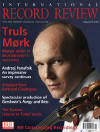Texte paru dans: / Appeared in:
*

International Record Review - (05//2014)
Pour
s'abonner / Subscription information
CORO
COR16120

Code-barres / Barcode : 082802161202
(ID412)
Consultez toutes les évaluations recensées pour ce cd
~~~~ Reach all the evaluations located for this CD
Volume 1 of The Sixteen's recording of J, S. Bach's Lutheran Masses was highly commended on its release just a few months ago (I reviewed it in these pages in the January issue). This is Volume 2 and just like its companion volume it consists of two Masses flanking a central cantata, the latter acting as a hub for some of the musical material also to be found, variously and creatively re‑used and adapted, in the Masses. Looking back over this mini‑project, Harry Christophers contentedly recalls the concerts and recording sessions that resulted in these discs as being among 'the most wonderfully concentrated days of our existence', and that evidently special time spent together in the company of Bach's music is clearly transmitted. The performances seem agreeably convivial in spirit, even relaxed, the small performing forces enjoying a perceptible sense of partnership and easy collaboration which wholly justifies Christophers's decision to present the Masses on a chamber scale.
Cantata BWV79, Gott der Herr ist Sonn' und Schild, written to commemorate the Lutheran Reformation, supplies the music for three movements in the later Masses. Cantata BWV179 might just as well have been chosen (it too is the source of a further three movements), but the transformation of some of the material from BWV79 is superbly realized and as such gives an excellent and instructive demonstration of Bach's instinctive brilliance. Its opening chorus of celebration, a triumphant processional of horn fanfares and drumbeats, is turned into the opening section of the 'Gloria' of the G major Mass: the singers take the former horn parts and playfully turn the music into a delicate dance ‑ Christophers describes it as madrigalian. The transformation of mood is startling, especially as it is achieved by such apparently simple means. Much the same can be said of the reassigning of instrumental obbligatos. For example, the obbligato of the cantata aria 'Gott ist unsre Sonn' und Schild' takes on a different character altogether when it is transferred from solo oboe to, in the 'Quoniam' of the A major Mass, low‑pitched unison violins and viola; furthermore, to complement: Bach's changes of timbre and to extend, in a way, the same (re)creative process, Christophers assigns the two versions to two different, and differently voiced, countertenor soloists, Robin Blaze and William Purefoy.
Collectively, the soloists form an agile and efficient choir, and this is essential in music that is often technically difficult. Bach's tendency to set off on long fugal or imitative excursions in allegro movements requires from singers not only vocal stamina but also a clear sense of structure; the clarity of separate lines is important if the counterpoint is not to become lost. This is in part what lies behind Christophers's choice of scale and, in movements such as the 'Cum Sancto Spiritu' of the G major Mass, it works very well indeed. The added support of a second singer per part makes complete sense in those movements where Bach is using the singers as, effectively, concertino and ripieno groups in a concertante manner, as in the 'Cum Sancto Spiritu' of the A major Mass.
Both
volumes were recorded in the same session at St Augustine's Church, Kilburn,
in May 2013, with the same personnel, and the consistency in all aspects of
the recordings makes these an attractive and well programmed pair of discs.
The performances are excellent and the sound quality pleasingly clear and
natural. More attractive still, perhaps, would have been to package the
discs together as a single release, thus at least avoiding duplication of
the bulk of the booklet essay and other supporting notes which accompany
each one. There is of course additional mileage to be gained from exploring
links between these Masses and other cantatas not recorded here, and in this
respect the recordings offer just a taster of a larger potential project.
However, Christophers and The Sixteen have shown how it can be done, and
further such detective work can be followed up by the inquisitive listener.
Fermer la fenêtre/Close window
Cliquez l'un ou l'autre
bouton pour découvrir bien d'autres critiques de CD
Click either button for many other reviews


